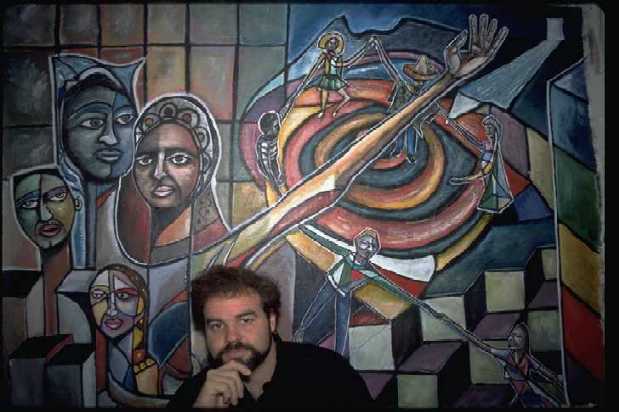
Hand in Hand Series
|
Hand in Hand Series |
HAND IN HAND: Xavier Cortada, Portrait of the Artist
Rooted in the artist's personal explorations of gang violence, drug abuse and poverty in urban Miami, the varied works of Xavier Cortada speak to the cycle of social ills that pain modern society.
The artist, an attorney and adjunct assistant professor of psychiatry at the University of Miami, has used his works to reach the people of four continents: He has had extensive exhibitions and presentations throughout Africa and Europe, and has worked with school children in Medellin to design a mural urging community members to stop the violence.
In Leadville Colorado, Cortada worked with recent immigrants, established Hispanic families, school children, and church groups to design the mural Hand in Hand, which encourages a divided community to come together.
Graphically, the stark, angular images dominating Cortada's canvas contrast with the warm tones inspired by the artist's cultural roots in tropical Cuba. The effect, at once startling and poignant, captures a snapshot of human conflict.
In Devouring Fears, the artist explores the tortured conflict of drug addiction. An aggressive, horrific half-face representing a young man's narcotic lust consumes the peaceful side of himself. He remains a victim of a raging inner tug-of-war.
Urban Slave is the portrait of a 16-year-old gang member who was involved in a youth group Cortada led in the aftermath of the 1990 Wynwood disturbances. In this shadowy work, the downcast teen is succumbing to societal ills that make him a modern-day slave to drugs and violence.
Widely explored is the plight of poverty-stricken women, all too often emotionally imprisoned by society -- and the men who share their condition.
America's Cindarella (Welfare Mom) is blaring imagery about the cycle of poverty that is so hard to break free of, and the socially-imposed fairy tale that says these women are caught in the cycle by choice.
In America's Last Supper, Cortada indicts a legislature that would give birth to Proposition 187 in the looming presence of an anguished Hispanic child reaching into the empty recesses of welfare reform, his mother rendered impotent by mindless decrees.
The very function of a social sector that unfairly judges women is explored in Voyeur, in which we see the misogynists judging an undressing woman, frightened, cast down and exposed by the condemning gapes of her onlookers.
Feminism is also studied in La Profeta, where a prophet sits atop a medieval balcony overlooking an urban center that swiftly sprawls towards ageless mountains, slow in their erosion. Tireless, she witnesses women's role in society, and through her chronicles inspires change.
Modern man's afflictions are depicted in Disarmed, Disheartened, Emasculated--the consequences of changing societal roles, fragile interpersonal relationships and alienation.
In Lover, a man carrying his withered companion bears three faces -- one for mourning his diseased partner, another for past lovers he has lost, and another for future lovers he is damned to lose again to AIDS.
Multiple-faced imagery runs thematic throughout Cortada's work.
Cortada sheds light on the multi-cultural essence of a city that would deny its blending roots in Secret, the faces of Miami coming together to speak one language..
In Conquistador, Cortada offers a representation of modern American civilization, flanked by its predecessors -- on the left, Mayan, on the right Spanish.
Multi-cultural themes have been present in Cortada's work since 1979, when at 15, he developed Los Primeros Cristianos, America's first-evangelized natives.
In style and content, Cortada, like his artist father and uncle before him, draws inspiration from the Cuban School of modern art, evoking the pathos of Amelia Pelaez, and the Southern Lands integrity of Wifredo Lam.
And yet he offers the fresh point of view of a young Cuban-American born in Albany, New York and raised in Miami, gracefully balancing the influences of two cultures, teetering between two languages.
His heart beats at once for his northern birthplace and for a tropical homeland he knows only through the reminisces of his parents.
In Drownings, Cortada captures the political disaster that is Cuba in the stark imagery of destitute islanders, doomed rafters, tortured virgins -- all of it shrouded by the great evil of a hemisphere that hides its head like an ostrich, even while it brandishes the magenta, lavender and blue banner of the historic Summit of the Americas.
Through If You Want Peace Fight for Justice the artist admonishes the viewer to seek demonstrable ways of creating a more equitable society. The peace dove, representing the global community, leads by redistributing the earth's resources to effectuate lasting positive change.
In probing the confines of the rawest human conditions, Cortada manages an evolving body of work that jars us through its modern relevance. A historian wielding color on canvas, the artist forces us to confront a disturbing mirror that, in the end, reflects the dark side of a society built of our own construction.
![]() Click here to see Hand in Hand Series paintings listing
Click here to see Hand in Hand Series paintings listing
![]() Click here to return to Xavier Cortada Gallery
of Paintings Menu
Click here to return to Xavier Cortada Gallery
of Paintings Menu
|
to return to the home page of the |
||
xavier cortada |
||
gallery of paintings and community murals |
||
Xavier Cortada has exhibited his paintings in museums and galleries across the United States, Latin America, Africa, and Europe, and has worked with diverse community groups to create pro-social murals. |
||
Copyright © 1997 by Xavier Cortada. All
rights reserved.
Revised: 14 Apr 2003 23:12 -0400.